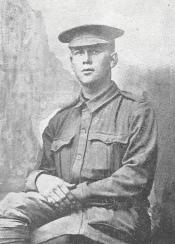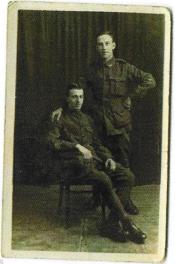 George Stephens lived in Port Melbourne and enlisted, underage, in July 1915 as part of the great recruitment campaign at that time. After initial training at Broadmeadows Camp, along with 153 comrades he sailed from Melbourne on the RMS ‘Osterley’ as part of the 5th reinforcements, 22nd Battalion. On arrival in Egypt he was hospitalised for eighteen days with diarrhoea, before re-joining the Battalion and sailing for France on the ‘Llandovery Castle’ (later to be controversially sunk as a Hospital Ship by a German U-boat).
George Stephens lived in Port Melbourne and enlisted, underage, in July 1915 as part of the great recruitment campaign at that time. After initial training at Broadmeadows Camp, along with 153 comrades he sailed from Melbourne on the RMS ‘Osterley’ as part of the 5th reinforcements, 22nd Battalion. On arrival in Egypt he was hospitalised for eighteen days with diarrhoea, before re-joining the Battalion and sailing for France on the ‘Llandovery Castle’ (later to be controversially sunk as a Hospital Ship by a German U-boat).
In March 1916 the 22nd Battalion was one of the first Australian units to arrive in France. The first few months were spent in the relatively quiet sector around Armentieres, but that was all to change in July with the start of the Somme offensive, and on 26th July the 22nd were in to the battle at Pozieres, the most bloodiest and costly battle fought by the AIF. It was towards the end of the Somme offensive at Flers on 13th November that George suffered gunshot wounds to the leg and buttocks, where it was said that stretcher bearers could take up to seven hours to carry the wounded back to the dressing station due to the mud.
George spent the winter months recovering in hospital in England before returning to the Battalion on the Somme in March 1917. However after only two days he was heading back to England having received a gunshot wound to the foot. After recovery he was stationed at the AIF training camp in Wiltshire, where his service records show a number of ‘pay deducted’ for various misdemeanours, before returning in November to the Battalion now stationed in Ypres, Belgium.
In April 1918 the Battalion headed south to help halt the German Spring Offensive, so the Battalion found itself fighting hard to keep the Somme ground that was gained with great sacrifice two years previously. Three days after getting to the frontline, George was shot in the chest defending the line at Dernancourt, and was hospitalised at Etaples on the French coast. Within four weeks he had returned to Battalion and the Somme, and on the 11th June he suffered his fourth wounding through a gas attack.
By the time George re-joined the Battalion in September, the final Allied offensive spearheaded by Monash and the Australian Divisions was well underway and the German Hindenburg defensive line lay ahead. On the 4th October, the second from last day of fighting by the Australian Divisions on the Western Front, George received the Military Medal for gallantry. The citation read ‘When volunteer stretcher bearers were called for, this man ran out to the assistance of the wounded in broad daylight. He had to cross exposed and bullet-swept ground in close proximity to enemy posts, but worked for hours unremittingly, succoring his wounded comrades and carrying them back to shelter. In performance of this work he showed absolute courage of self-sacrifice that had a marked effect on the morale of all with whom he came in contact.’
 George’s exploits on the Western Front were not over – on the 11th November (Armistice Day), he along with his best mate Charles Samways (photographed together) went absent without leave for three weeks and received a Court Martial and 40 days detention. Before returning to Australia George went back to England and married Minnie Taylor in Twickenham. On 25th September 1919 they sailed together on the ‘Mahana’, the so called ‘bride boat’ on account of so many soldiers having married their war time sweethearts. George was discharged from the army on 9th January 1920.
George’s exploits on the Western Front were not over – on the 11th November (Armistice Day), he along with his best mate Charles Samways (photographed together) went absent without leave for three weeks and received a Court Martial and 40 days detention. Before returning to Australia George went back to England and married Minnie Taylor in Twickenham. On 25th September 1919 they sailed together on the ‘Mahana’, the so called ‘bride boat’ on account of so many soldiers having married their war time sweethearts. George was discharged from the army on 9th January 1920.
George and Minnie had their first daughter in Melbourne but, not helped by the premature death of George’s mother Polly in 1920, Minnie could not settle so in 1924 they returned to the house in Twickenham where they had another three children, and where the next two generations of Stephens lived and grew up. George became a labourer, and died in 1968 aged 70. Charles Samways married George’s sister Daisy in 1920, and they lived in Maribyrnong until Charles died in 1977 aged 81.
George’s story could be the epitome of an Australian infantryman. Generations of soldiers have returned from the front and spoken little of the horrors that they endured during war. Our grandfather was no different in this respect. It has only been through the uncovering of details through service records and battalion diaries that we have been able to start to piece together what these brave young men endured and accomplished.


 FIRST WORLD WAR TIMELINE
FIRST WORLD WAR TIMELINE